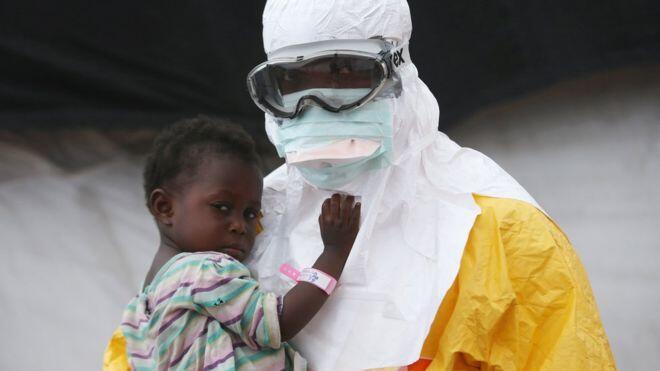The majority of cases in the world’s largest outbreak of Ebola were caused by a tiny handful of patients, research suggests.
The analysis, published in Proceedings of the National Academy of Sciences, shows nearly two thirds of cases (61%) were caused by 3% of infected people.
The young and old were more likely to have been “super-spreaders”.
It is hoped understanding their role in spreading the infection will help contain the next outbreak.
More than 28,600 people were infected with Ebola during the 2014-15 outbreak in west Africa and around 11,300 people died.
How did it spread?
The study looked at cases in and around the capital of Sierra Leone, Freetown.
By looking at the pattern of where and when cases emerged, the researchers could tell how many people each infected person was passing the deadly virus onto.
Prof Steven Riley, one of the researchers at Imperial College London, told the BBC News website: “Most cases had a relatively short infectious period and generated low numbers of secondary infections, whereas a small number had longer infectious periods and generated more infections.
“The findings are likely an accurate description of what happened.”
The majority of cases in the world’s largest outbreak of Ebola were caused by a tiny handful of patients, research suggests.
The analysis, published in Proceedings of the National Academy of Sciences, shows nearly two thirds of cases (61%) were caused by 3% of infected people.
The young and old were more likely to have been “super-spreaders”.
It is hoped understanding their role in spreading the infection will help contain the next outbreak.
More than 28,600 people were infected with Ebola during the 2014-15 outbreak in west Africa and around 11,300 people died.
How did it spread?
The study looked at cases in and around the capital of Sierra Leone, Freetown.
By looking at the pattern of where and when cases emerged, the researchers could tell how many people each infected person was passing the deadly virus onto.
Prof Steven Riley, one of the researchers at Imperial College London, told the BBC News website: “Most cases had a relatively short infectious period and generated low numbers of secondary infections, whereas a small number had longer infectious periods and generated more infections.
“The findings are likely an accurate description of what happened.”
Children under 15-years-old and adults over 45 were more likely to be spreading the virus.
“My feeling is this may be explained by human behaviour,” said Prof Riley.
“It may not even be the cases, but the people around them.
“I wonder whether it is to do with people coming to care for the young or old.”
Infection hallmark
Super-spreaders have been implicated in other outbreaks, including severe acute respiratory syndrome (Sars) and Middle East respiratory syndrome (Mers).
They seem to be a hallmark of emerging infections that are jumping from animal to human hosts. The knowledge could help contain future outbreaks by targeting resources at the super-spreaders.
Huge efforts went into contact-tracing during the Ebola outbreak, which could be focused on super-spreaders in the future. The study may also feed into plans to prepare a stockpile of Ebola vaccine.
Prof Jonathan Ball, a virologist at the University of Nottingham, told the BBC: “The recent West African outbreak was on an unprecedented scale and many cases, especially those occurring out in the community, appear to have arisen from a surprisingly small number of infected individuals.
“Knowing who is most likely to transmit the virus can help in focusing interventions designed to prevent virus spread, and the current study suggests that infected children and the elderly were more likely to pass their virus on.
“Whether this was this due to biological or social factors is unclear, and these will be important questions to address if we are to understand how Ebola virus super-spread occurs.”
The research was a collaboration between Princeton University, Oregon State University, the London School of Hygiene and Tropical Medicine, the International Federation of Red Cross and Red Crescent Societies, Imperial College London and the US National Institutes of Health.
Follow James on Twitter.











